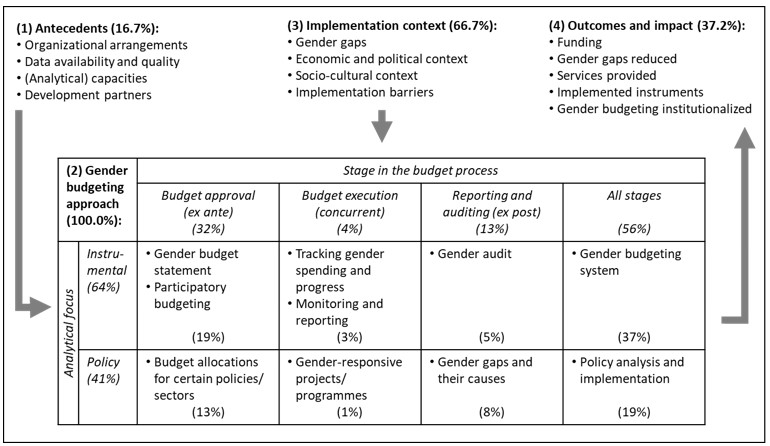
Posted by Tobias Polzer, Isabella M. Nolte, and Johann Seiwald[1]
Gender budgeting has not only encouraged countries to adopt reforms but also researchers to undertake studies and publish articles. A recent study[2] conducts a systematic literature review in peer reviewed journals covering 78 studies beginning in the 1990s. It seeks to elicit avenues for advancing gender budgeting.
The study identifies an increased scholarly interest in gender budgeting issues over the years. During 2017-2020, six to seven papers were published each year compared to only 0.4 studies on average in the 1990s. About 30 percent of these studies concentrate on European countries with an emphasis on high-income countries such as Austria or Spain while there were only three studies of emerging European economies such as North Macedonia and Serbia. Several studies assessed emerging economies in Asia (24.7 percent) and emerging and low-income economies in Africa (17.8 percent). Only two studies in the sample look at the Americas (Canada and the USA). No studies were found on Latin America, despite the policy efforts in some countries of that region.
To categorize the contents of the academic papers, the study develops a framework that includes the following dimensions (1) antecedents, (2) approaches, (3) implementation, and (4) outcomes and impact. The figure below describes this framework. Some studies covered more than one category, so that totals may exceed 100 percent.
(1) Antecedents: Several studies note the relevance of the enabling environment such as data availability, political support, multi-stakeholder engagement, or lack of governmental analytical capacity. They conclude that lack of gender-disaggregated data makes it difficult for governments to tailor their policies and programs to reduce gender disparities.
(2) Approaches: Governments can approach gender budgeting either from an operational or a policy perspective. Two-thirds of countries in the sample focused on operational aspects of gender budgeting, such as issuing gender budget statements or conducting gender audits. Around 40 percent focused on the analysis and implementation of fiscal policy, or on budget allocations for certain policies and sectors. Only a few studies adopted both perspectives.
In addition, the framework differentiates the role of gender budgeting at the different stages of the budget process. Around half of the countries undertook a comprehensive review of gender budgeting, covering all stages of the budgeting process. About one-third focused on upstream policies and instruments of gender budgeting, such as macro fiscal analysis and budget preparation. Relatively few studies reviewed downstream aspects of budgeting such as budget execution (4 percent) or financial reporting and auditing (13 percent).
(3) Implementation: Two-thirds of the studies discussed the specific country context of implementing gender budgeting. Some of these studies found that governments were using unsuitable tools, following a piecemeal approach, or neglecting current academic and practitioner guidance on good international practices. Often gender budgeting initiatives are easily implemented if resources – such as finance, time, and needed expertise – are available, but become more challenging when resources are limited or reforms face resistance from different stakeholders. Progress on implementing gender budgeting may also be adversely affected by economic crises, the COVID-19 pandemic, and government austerity programs. Some of the papers thus call for gender budgeting to be strategically underpinned in legislation or policy-making procedures, e.g., fiscal policy documents and cabinet discussions.
(4) Outcomes and impact: One-third of the studies discussed the outcomes and impact of gender budgeting policies. Some studies offer practical recommendations at different levels – international, national, and organizational. Other studies argued that the design and implementation of gender budgeting initiatives need to include a dialogue of stakeholders at both the national and subnational levels of government.
The study draws several conclusions for policy makers and practitioners: (i) future work should focus on both the upstream and downstream phases of budgeting; (ii) policy makers should elevate gender budgeting to center stage on the political map and institutionalize the reforms so that progress can be made during times of instability and crisis; and (iii) to avoid ‘investment ruins’, governments (and scholars) need to evaluate the outcome and impact of gender budgeting initiatives in a timely fashion to understand which approaches are working and where adjustments need to be made.
[1] Tobias Polzer is an Assistant Professor at WU Vienna University of Economics and Business, Austria. Isabella M. Nolte is a Professor at Harz University of applied Sciences. Johann Seiwald is a Senior Budget Expert at the Austrian Parliamentary Budget Office and a consultant for the IMF and the World Bank.
[2] “Gender Budgeting in Public Financial Management: A Literature Review and Research Agenda”. International Review of Administrative Sciences. July 2021. https://doi.org/10.1177/00208523211031796
Note: The posts on the IMF PFM Blog should not be reported as representing the views of the IMF. The views expressed are those of the authors and do not necessarily represent those of the IMF or IMF policy.






